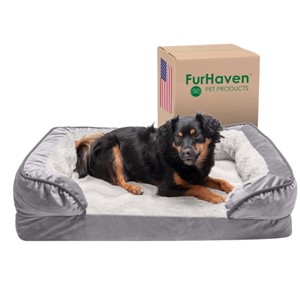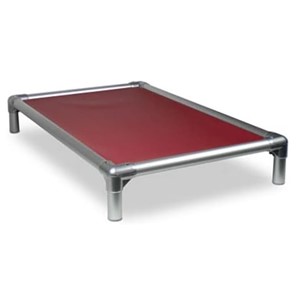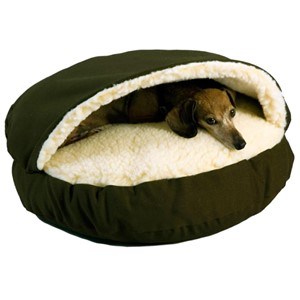Best Dog Beds for Beagles
Comfortable Dog Beds are Best for Beagles!
Introduction
The best dog beds for Beagles must consider some factors that crater to their specific needs and preferences. Because of health issues, orthopedic beds are best.
Beagles are beloved for their friendly demeanor, expressive faces, and unmistakable howl. Originating as hunting dogs, Beagles are one of the oldest breeds known, dating back to ancient Greece.
They are small to medium-sized dogs with a distinctive tricolored coat and long, drooping ears. Known for their keen sense of smell and gentle temperament, Beagles make wonderful family pets and companions.
They thrive on companionship and enjoy activities that engage their curious nature. With their playful and sociable personality, Beagles continue to capture hearts as cherished members of many households worldwide.
In this article, we want potential owners of Beagles to know about the costs, best beds to buy, health concerns, and some facts about the dog breed.
Best Dog Beds for Beagles
Below are some factors you should consider when buying a dog bed for your Beagle.
- Orthopedic Dog Beds: Beagles, like many other breeds, can benefit from orthopedic support, especially as they age or if they have joint issues like hip dysplasia and arthritis. These beds typically feature memory foam or other supportive materials that cushion joints and provide comfort.
- Washable Dog Beds: Beagles are known for their tendency to get dirty, especially after outdoor adventures. Washable dog beds are convenient because their covers can be easily removed and cleaned, helping to maintain hygiene and freshness.
- Raised Dog Beds: Beagles enjoy having a comfortable spot that is slightly elevated off the ground. Raised dog beds provide good airflow, which can be beneficial in warmer climates, and they often come with durable frames that can withstand Beagles’ energetic movements.
- Cave or Hooded Dog Beds: Beagles are a hound breed and sometimes appreciate having a cozy, enclosed space to retreat to. Cave or hooded dog beds provide a sense of security and warmth, mimicking their natural inclination to burrow.
- Waterproof Dog Beds: Given Beagles’ love for exploring and potentially getting wet or dirty, waterproof dog beds are practical. These beds resist moisture, making cleanup easy and preventing odor buildup.
- Multi-Functional Dog Beds: Beagles are active dogs that might appreciate a bed that serves multiple purposes, such as a combination bed and crate mat or a travel-friendly bed that can be easily folded or rolled up.
- Chew-Resistant Dog Beds: Beagles can be chewers, especially when they are puppies or if they get bored. Chew-resistant dog beds are designed with durable materials that can withstand scratching and chewing, extending the bed’s lifespan.
- Look for the CertiPUR-US Seal: When buying an orthopedic dog bed, look for the CertiPUR-US seal. This means that the materials used in making the bed do not contain any toxins and chemicals that are harmful to humans and animals.
- Know Your Dog’s Sleeping Position: It is important to match your dog’s sleeping style with the dog bed. The basic sleeping positions for Beagles are stretching out (a rectangle bed is best) or resting their head and body against something (a bolster bed fits this style well).
Tip 1: Be sure to place the dog bed out of the way of heavy traffic and drafty areas of the house. Dogs like to have a place they can call their own when they rest and sleep. Tip 2: You may want to consider using a crate for their bed. It is a place that they can call their own and keep them out of trouble during the day or when you are at work. It is best to train them to use the crate as a puppy. Each of these types of dog beds can cater to different needs and preferences of Beagle owners, addressing both practical considerations (like cleanliness and durability) and the comfort requirements for their companions.
Facts About Beagles
Below are some interesting facts about Beagles you may not know about.
Types of Beagles
- Standard Beagles
- Male Beagles: Height: 14 to 16 inches tall Weight: 20 to 30 lbs. Body Length: 22 to 25 inches Lifespan: 12 to 15 years Full Grown: 18 months
- Female Beagles: Height: 13 to 16 inches Weight: 20 to 22 lbs. Body Length: 20 to 24 inches Lifespan: 12 to 15 years Full Grown: 18 months
- Pocket Beagles (Under 13 Inches Tall)
- Height: 7 to 12 inches, Weight: 7 to 15 lbs. Body Length: 20 to 24 inches Lifespan: 12 to 15 years Full Grown: 18 months
Facts
- Origin: Beagles are one of the oldest dog breeds, dating back to ancient Greece around 500 BC. They were primarily bred for hunting small game like rabbits.
- Appearance: Beagles have a distinct look with a short coat that is usually tricolored (black, white, and tan), a broad head, and long ears that are often soft and floppy.
- Temperament: Known for their friendly and gentle disposition, Beagles are excellent family pets. They are sociable, curious, and generally good with children and other pets.
- Exercise Needs: Beagles are energetic dogs that require regular exercise to keep them healthy and happy. They enjoy activities like walks, runs, and playtime in a securely fenced yard.
- Scent Hounds: Beagles have an incredible sense of smell and were originally bred for tracking scents. They have a keen nose and can easily get distracted by interesting scents during outdoor walks.
- Vocalization: Beagles are known for their distinctive baying howl, often referred to as a “bark.” This vocalization is characteristic of the breed and is used when they sense prey or when they are excited.
- Intelligence: Beagles are intelligent dogs but can be stubborn when it comes to training. Positive reinforcement techniques and patience are key to effectively train them.
- Health: While generally healthy dogs, Beagles can be prone to certain health issues like obesity (due to their love for food), hip dysplasia, and epilepsy. Regular vet check-ups and a healthy diet are important.
- Pop Culture: Beagles have been popular in pop culture and media, with notable appearances in movies and TV shows such as “Snoopy” from the Peanuts comic strip and “Shiloh” from the children’s book series.
- Beagles Can Gain Weight Rapidly: Vets have noticed an increasing trend of obesity among Beagles in the city. So, when you are giving them treats during training or playtime, make sure they do not exceed more than 10% of their daily caloric intake. As the owner, you need to prevent them from becoming overweight or obese.
- Beagles’ Tails Are Like White Flags: Many Beagles have white-tipped tails. This white tip was bred into Beagles so that they would be visible when they had their noses to the ground during a hunt.
- Their Ears Help Their Noses: According to the AKC breed standard, Beagles’ ears, when drawn out, reach the end of their nose. Those long ears actually catch scent particles and keep them close to the dog’s nose, so they can take in as much information as possible. The scent particles also get trapped in the folds of wrinkly skin, allowing the dogs to carry reference samples as they hunt.
- Beagles Can Vocalize Three Ways: The Beagle is one of the most vocal dog breeds. They can make three different sounds—a standard bark, a yodel bark sound called by bay (which is used when hunting to alert other dogs), and a howl (which means they picked up the scent).
- Many Beagles Have Jobs: A Beagle’s incredible sense of smell makes them a great working dog. Beagles are often used as bedbug detectors. DHS uses Beagles in airports to find food in passengers’ luggage, in order to prevent the spread of foreign diseases and parasites.
- The Modern Beagle Hounds: The modern beagle hounds that we see was developed around the 1830s in Great Britain. Beagles are possibly the result of crosses between the Harrier, Talbot Hound, North County Beagle and Southern Hound. The beagle breed was specifically created to track and hunt rabbits and hares by their scent.
Common Health Conditions
As a potential Beagle owner, we share some of the common health conditions that Beagles may experience in their lifetime.
- Obesity: Beagles are prone to obesity because they have a tendency to overeat. It’s important to monitor their diet and ensure they get enough exercise to maintain a healthy weight.
- Hip Dysplasia: This is a common skeletal condition where the hip joint doesn’t fit together properly, leading to arthritis and discomfort. It can be managed with proper diet, exercise, and sometimes surgery.
- Intervertebral Disc Disease (IVDD): Beagles, like many other breeds with long backs, can be prone to IVDD. This condition affects the spinal discs and can cause pain, weakness, and even paralysis in severe cases.
- Epilepsy: Beagles may suffer from epilepsy, which is a neurological disorder characterized by recurring seizures. Medication can often control seizures effectively.
- Hypothyroidism: This occurs when the thyroid gland doesn’t produce enough hormones, leading to weight gain, lethargy, and skin issues. It can usually be managed with medication.
- Cherry Eye: This is a condition where the gland of the third eyelid prolapses and becomes visible as a red mass in the corner of the eye. Surgery is often required to correct it.
- Ear Infections: Beagles’ long, floppy ears can be prone to infections if not kept clean and dry. Regular ear cleaning can help prevent this.
- Allergies: Beagles can suffer from allergies to various environmental factors (like pollen or dust) or food allergies. Symptoms may include itching, skin irritation, and ear infections.
- Glaucoma: This condition involves increased pressure within the eye, which can lead to pain, vision loss, and eventually blindness if not treated promptly.
- Heart Disease: Beagles can be prone to certain heart conditions, such as mitral valve disease, which affects the heart valves and can lead to heart failure over time.
Regular veterinary check-ups, a balanced diet, maintaining a healthy weight, and providing adequate exercise are essential for helping to prevent or manage these health conditions in Beagles. Early detection and treatment can significantly improve the quality of life for your Beagle.
Costs of Owning A Beagle
Owning a Beagle entails several costs that prospective owners should consider. Here’s a breakdown of the typical expenses associated with owning a Beagle:
- Initial Purchase: The cost of acquiring a Beagle puppy from a reputable breeder can range from $500 to $1500 or more, depending on factors such as lineage, pedigree, and location.
- Veterinary Care: Annual veterinary expenses for routine check-ups, vaccinations, and preventative care (like flea and tick prevention) can range from $200 to $600 or more, depending on your location and the health of your dog.
- Food and Treats: Beagles are medium-sized dogs with a healthy appetite. Expect to spend about $300 to $700 annually on high-quality dog food and treats.
- Grooming: Beagles have a short coat that requires regular brushing and occasional baths. Grooming costs (including brushes, shampoos, and occasional professional grooming) can range from $50 to $200 annually.
- Training and Socialization: Training classes, treats for positive reinforcement, and socialization activities can cost around $100 to $300 per year, depending on whether you opt for group classes or private sessions.
- Toys and Accessories: Beagles enjoy toys and accessories that stimulate their minds and bodies. Plan to budget about $50 to $200 annually for toys, beds, leashes, and other essential accessories.
- Pet Insurance: Optional but recommended for unexpected medical emergencies, pet insurance premiums typically range from $300 to $600 annually, depending on coverage and deductible choices.
- Miscellaneous Expenses: This includes things like licensing fees, doggy daycare or boarding costs (if needed), and occasional purchases like new collars or tags, totaling around $100 to $300 per year.
- Total Annual Cost: On average, the total annual cost of owning a Beagle can range from approximately $1,500 to $4,000 or more, depending on your location, lifestyle, and the specific needs of your dog.
It’s important to budget for both expected and unexpected expenses to ensure your Beagle receives the care and attention it deserves throughout its life.
Conclusion
Owning a Beagle can be rewarding, fun, and bring comfort to you and other family members. Beagles do have some needs that potential owners should be aware of.
We shared some of them in this article, which included medical concerns, socialization, exercise, and obesity. Knowing your dog’s sleeping style will help you in selecting the proper dog bed for them.
Because of their health issues, an orthopedic dog bed is best especially as they age. We shared the potential costs of owning a Beagle so you can plan your budget accordingly.
Giving your dog the proper care and attention will go a long way in providing them a healthful life.
You can read about our other dog breed information articles by clicking HERE!
Shop Dog Beds
Shop dog beds for your dog by selecting or clicking on any bed of choice. You will be taken to Amazon where you can read customer reviews and answered questions and place the order.
As an Amazon Associate, I earn from qualifying purchases. Your purchase price is the same as if you shop directly on Amazon.
The price at time of publish is included below to give you an idea of what the price is; however, it is subject to change.
Cooling Gel Dog Beds

The Green Pet Shop Cooling Mat
Price At Time of Publish $40.00

MH MYLUNE HOME Self Cooling Mat
Price At Time of Publish $40.00

Furhaven Pet Products Cooling Gel Bolsters Small Bed
Price At Time of Publish $45.00

Furhaven Cooling Gel Medium Bed
Price At Time of Publish $42.00

ARF Pets Cooling Gel Pad
Price At Time of Publish $35.00

Furhaven Cooling Gel Small Bed
Price At Time of Publish $50.00
Price At Time of Publish $50.00
Orthopedic Dog Beds

PetFusion Orthopedic Dod Bed
Price At Time of Publish $80.00

Brindle Orthopedic Bed Khaki
Price At Time of Publish $30.00

Friends Forever Orthopedic Bolster Bed
Price At Time of Publish $53.00

K9 Ballistics Tough Orthopedic Small Crate Bed
Price At Time of Publish $89.00

MidWest Homes Small Bolster Dog Bed
Price At Time of Publish $10.00

JOYELF Orthopedic Small Sofa Bed
Price At Time of Publish $40.00
Bolster Dog Beds

Furhaven Small-Medium Bolster Dog Bed
Price At Time of Publish $57.00

Yiruka Small Bolster Sofa Dog Bed
Price At Time of Publish $40.00

K&H Pet Products Bolster Crate Pad
Price At Time of Publish $22.00

Leasure Small Bolster Dog Bed
Price At Time of Publish $40.00

Furhaven Small-Medium L-Shaped Bed
Price At Time of Publish $39.00

Long Rich Bolster Small Bed
Price At Time of Publish $27.00
Elevated Dog Beds

K9 Ballistics Chew Proof Elevated Small Bed
Price At Time of Publish $129.00

Bedsure Medium Elevated Dog Bed
Price At Time of Publish $33.00

Veehoo Medium Elevated Dog Bed
Price At Time of Publish $45.00

K&H Pet Products Elevated Bolster Dog Bed
Price At Time of Publish $57.00

Kuranda Elevated Chew Proof Small Dog Bed
Price At Time of Publish $134.00

Coolaroo Small Elevated Dog Bed
Price At Time of Publish $21.00
Shop Cave/Donut Dog Beds

Snoozer Cozy Cave Bed
Price At Time of Publish $87.00

Best Pet Supplies Tent Bed
Price At Time of Publish $23.00

Furhaven Round Orthopedic Cave Bed
Price At Time of Publish $30.00

Best Friends by Sheri Original Calming Donut Bed
Price At Time of Publish $25.00

Coohom Oval Calming Donut Cuddler Bed

JOEJOY Calming Donut Small Dog Bed
Price At Time of Publish $33.00

Bedfolks Calming Donut Dog Bed
Price At Time of Publish $66.00

Bedsure Medium Donut Dog Bed
Price At Time of Publish $36.00

Bedsure Medium Donut Dog Bed
Price At Time of Publish $40.00
- Best Dog Training Toys
- Best Healthy Dog Food Brands
- Christmas Presents for My Dog
- Critical Signs Your Dog Needs Help
- Dog Bed Warnings
- Dog Training Techniques
- How To Train A Puppy
- Ingredients To Avoid In Dog Treats
- Signs Your Dog Is Ill
- Using Alexa for Dog Behaviors
- What To Do for Dogs with Arthritis
